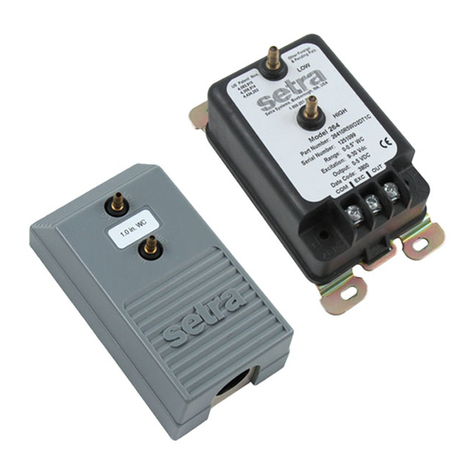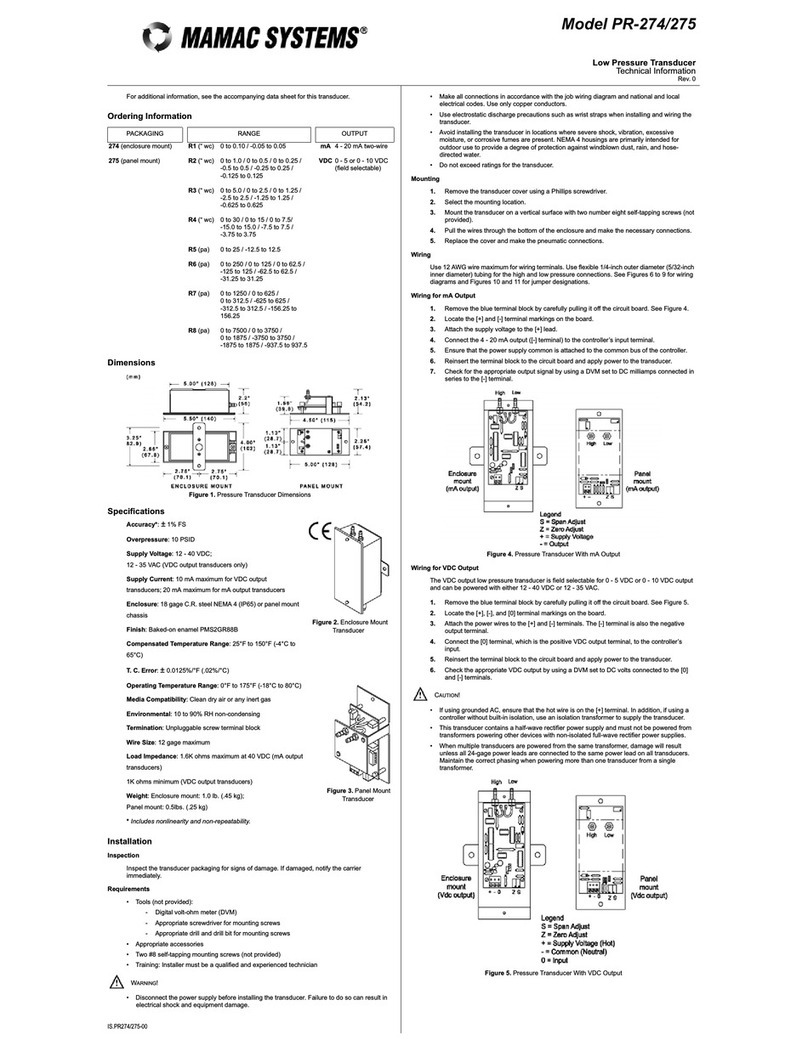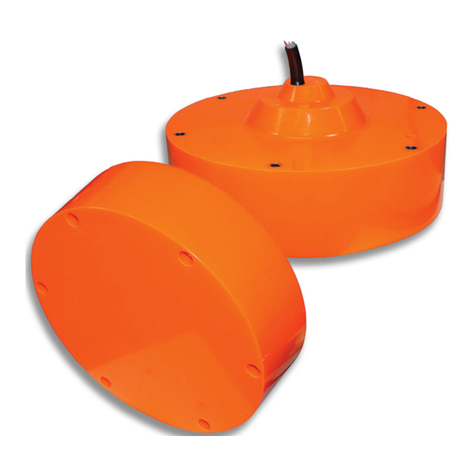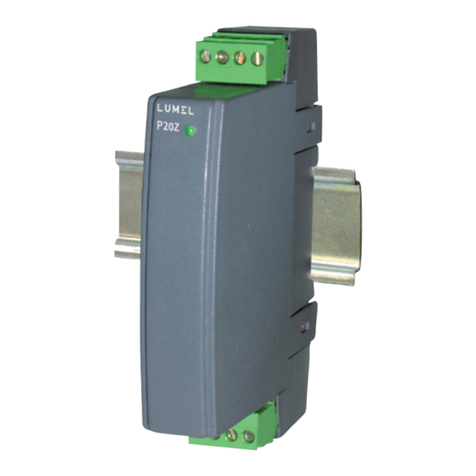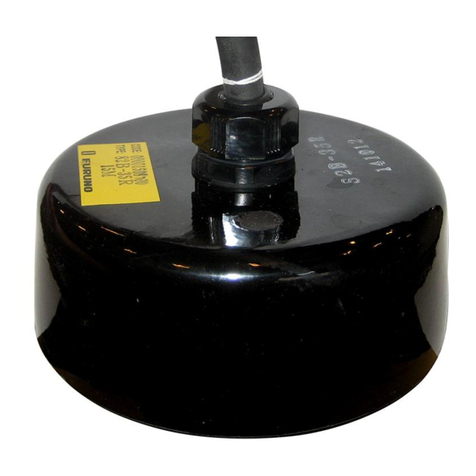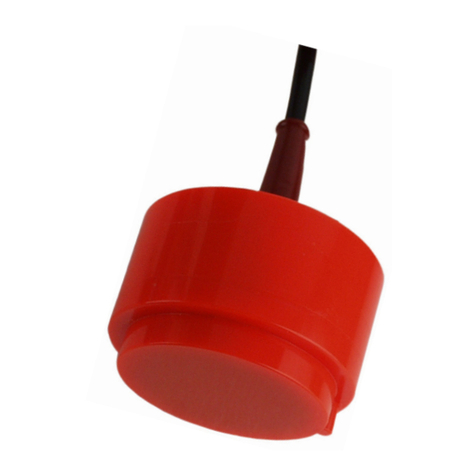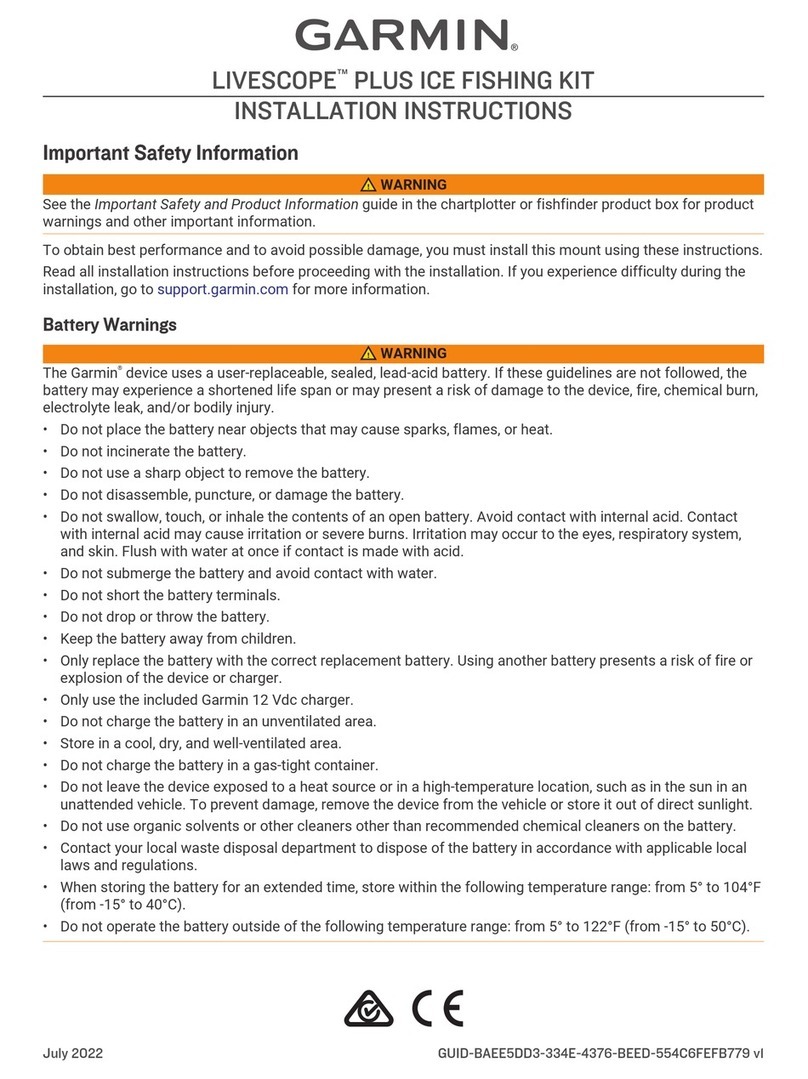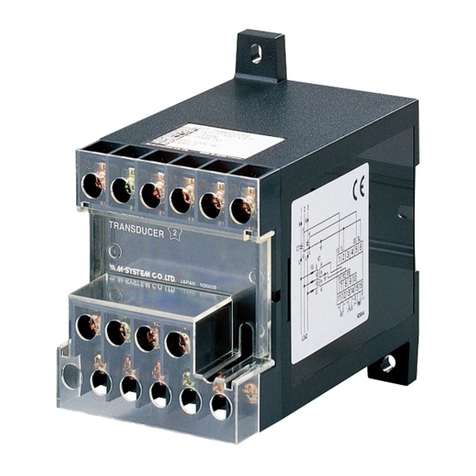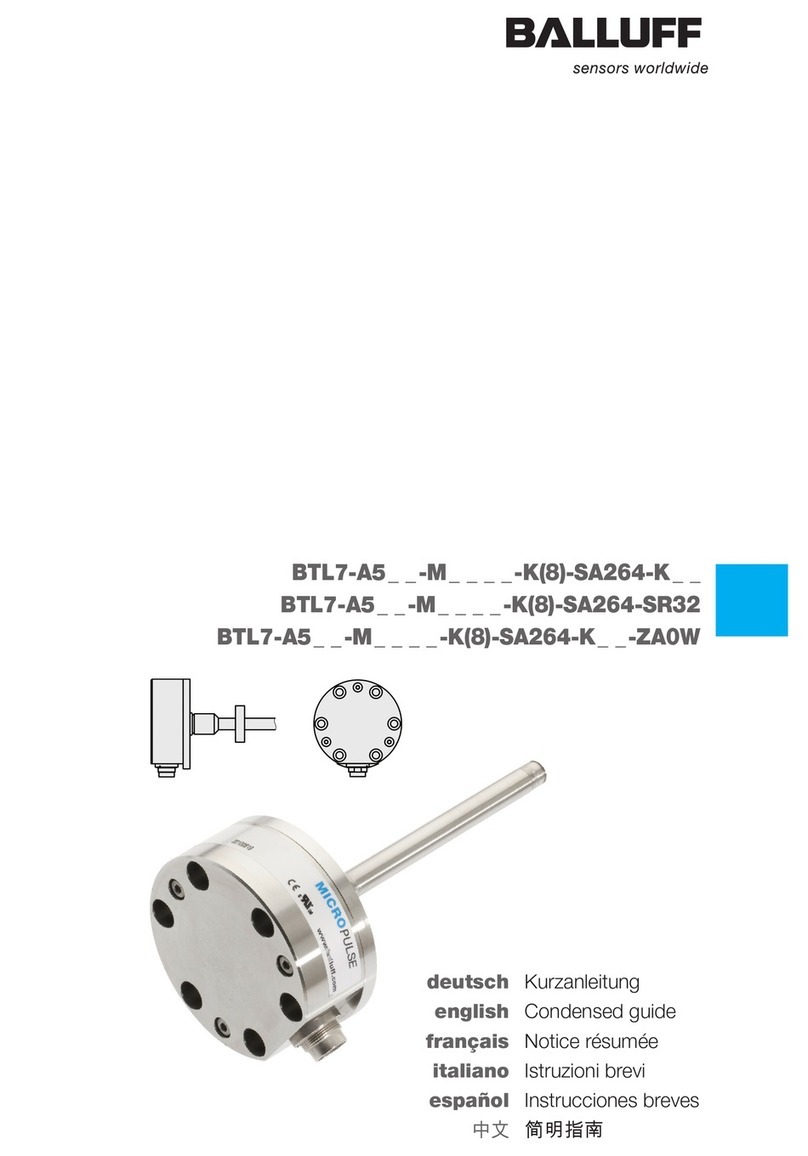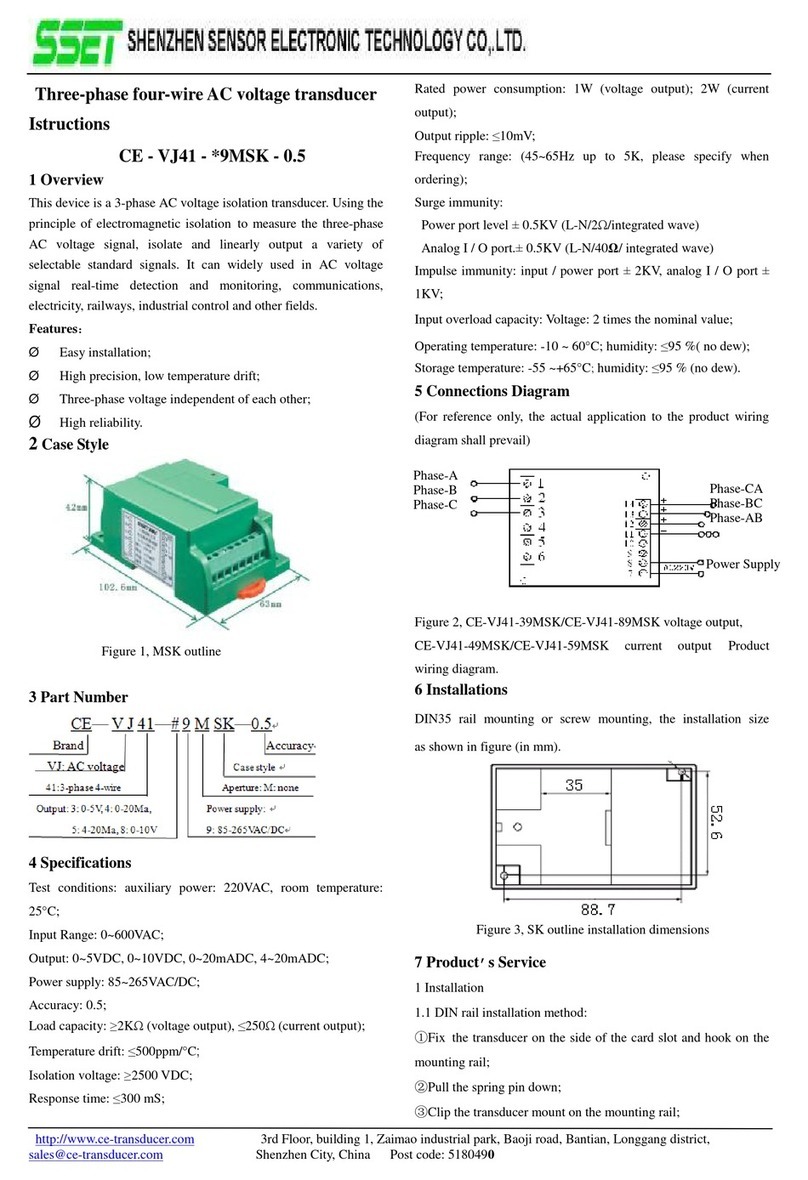Kron WA User manual

USER'S GUIDE
Power Transducer
WA / RA / WR
Review I

User's Guide
Power Transducer
Review I
KRON Instrumentos E étricos 2
Tab e of Contents
Chapter Page
Introduction 3
Term of Warranty 3
Technical Features 4
Wiring Diagrams 6
Single element, two-wire transducer WA or RA 6
Single element, two-wire transducer WR 7
Two elements, three-wire transducer WA or RA 8
Two elements, three-wire transducer WR 9
Three elements, four-wire transducer WA or RA
10
Three elements, four-wire transducer WR 11
Analog Output 12
Product Installation 17
Annex A: Product Coding 19
The information herein has the purpose of he ping in the correct use
and specification of WA, RA and WR Power Transducers.
Due to continued improvement, the information herein is subject to
changes without prior notice.

User's Guide
Power Transducer
Review I
KRON Instrumentos E étricos 3
Introduction
WA, RA and WR power transducers have the
function of measuring the active (W)
or reactive
(VAr) power in one-phase or three-
phase systems
(either balanced or unbalanced).
The power measurement is made with an analog
multipli
er, that uses the TDM (time division
multiplication) method, generating a DC output
signal, that may be of voltage (e.g.: 0-
10V) or of
current (e.g.: 4-
20mA), and is directly
proportional to the transducer's input. This output
signal is galvanically insula
ted from the
transducer's input.
Term of Warranty
Kron Instrumentos Elétricos Ltda ensures that its products are strictly
calibrated and tested, committing itself to repair them if possible manufacture faults
occur.
One (1) year warranty:
From the product's purchase date upon confirming the purchase invoice.
The warranty does not cover:
•Devices that have been tampered with.
•Disassembled or opened by unauthorized personnel.
•Damaged by overcharge or installation error.
•Used in a negligent or improper manner.
•Damaged by any kind of accident.
Maintenance:
Corrective maintenance, if necessary, should be carried out by Kron
Instrumentos E étricos'
specialized personnel, upon sending the
defective
part to our plant. The instrument cleaning, when necessary,
should be done only in external parts, using neutral material, and with all
electrical connections unplugged.
KRON Instrumentos E étricos
Rua Alexandre de Gusmão, 278
Socorro
São Paulo SP Brazil
ZIP code: 04760-020
PABX: (11) 5525-2000
Support: [email protected]
Website: www.kron.com.br
!

User's Guide
Power Transducer
Review I
KRON Instrumentos E étricos 4
Technica Features
Measurement Circuit
Type: Single-phase (F-N), Single-
phase
(F-F), Wye Three-
phase (3 elements, 4
wires) and Delta Three-
phase (2 elements,
3 wires).
Frequency: 50 or 60Hz (±10%)
Current Input
Rated: 1Aac or 5Aac
Effective Measurement Range:
10 to
110% of In
Short duration overcharge:
20 x In (1
sec)
Continuous overcharge: 2 x In
Power consumption: < 0,5VA
Vo tage Input
Rated: 110Vac 115Vac 150Vac
220Vac 380Vac 440Vac
Effective Measurement Range:
80 to
120% of Vn
Short duration overcharge: 1,5 x Vn
(1 sec)
Continuous overcharge: 1,2 x Vn
Power consumption: < 0,2VA
Auxi iary (or externa ) supp y
To be defined in the order, between these
options:
A ternated: 110 220 Vac (± 15%)
Continuous: 12 24 48
125 Vdc (±
20%)
Maximum power consumption: 5VA
Environmenta Conditions
Working Temperature: -10 to 60º C
Operating Moisture: 0-95% (no
condensing)
Temperature coefficient: 0.01%/°C
Mechanica Features
Fastening: With screws (4) in the panel
background.
Housing: Special extruded aluminum case
with high mechanical resistance and for
high temperatures.
Connections:
Through terminal strip with
M3 screws.
Protection degree: IP40 for housing and
IP00 for terminals.
E ectrica Features
Accuracy: 0.25% (under consultation:
0.2%)
Insu ation: 2kV (60Hz, 1 minute)
Impu se Test: 5kV 1.2/50us 0.5J
Output Ripp e: <0.5% (regarding full
scale)
Response Time: < 400ms
(others under consultation)
Standardizing
According to NBR 8145.

User's Guide
Power Transducer
Review I
KRON Instrumentos E étricos 5
Product's Dimensions
Dimensions in millimeters (mm). Tolerance: ±0.5mm

User's Guide
Power Transducer
Review I
KRON Instrumentos E étricos 6
Wiring Diagrams
Sing e e ement, two-wire transducer
WA or RA mode s

User's Guide
Power Transducer
Review I
KRON Instrumentos E étricos 7
Sing e e ement, two-wire transducer
WR mode

User's Guide
Power Transducer
Review I
KRON Instrumentos E étricos 8
Two e ements, three-wire transducer
WA or RA mode s

User's Guide
Power Transducer
Review I
KRON Instrumentos E étricos 9
Two e ements, three-wire transducer
WR mode

User's Guide
Power Transducer
Review I
KRON Instrumentos E étricos 10
Three e ements, four-wire transducer
WA or RA mode s

User's Guide
Power Transducer
Review I
KRON Instrumentos E étricos 11
Three e ements, four-wire transducer
WR mode

User's Guide
Power Transducer
Review I
KRON Instrumentos E étricos 12
Ana og Output
A transducer's principle is supplying a proportional linear output to an input
signal. The power transducer is intended to measure active power (W) and/or reactive
power (VAr). The output signal is always in direct current (D.C.). Thus:
Apparent power = V x I
Active power = V x I x cos φ
Reactive power = V x I x sen φ
And the output signal expresses the power value in a linear manner, as seen
below:
Example of input x output graph in a transducer with 1 000W as full scale and
4- 0mAdc output. Note that under 0W we have 4mAdc in output and under 1 000W,
we have 0mAdc in output.
Regarding the output types, there are two models:
1. Current type signa
It is a signal in the form of current. This is widely used in systems where the
module that will receive the signal is away from the transducer, once the voltage type
output transducer signal would suffer attenuation and consequent incorrect reading
due to the distance. The 4-20mAdc signal is an interesting manner to check if the
transducer is, indeed, working, as even if there is no input or if it equals 0, it should
provide a 4mAdc output.

User's Guide
Power Transducer
Review I
KRON Instrumentos E étricos 13
In this type of output, the maximum burden supported by the transducer is
specified.
Examples: 0-1mAdc, 0-10mAdc, 4-20mAdc, etc.
2. Vo tage type signa
It is a signal in the form of voltage. A minimum burden is specified for the
transducer, as it is not able to drain high currents in its output.
Examples: 0-1Vdc, 0-10Vdc, etc.
Connecting severa devices to a transducer
In many industrial automation processes there is the need of using a single
signal in several devices, such as a digital gauge and a PLC.
For current output transducers, the instruments should be connected in
series, according to the illustration below:
On the other hand, for vo tage output transducers, the instruments should be
connected in parallel:
The equiva ent resistance of the devices to be connected should always be
calculated, in order to verify if there will not be output saturation of the transducer,
which may lead it to be damaged or present unreal output values. The equivalent
resistance should always be within the allowed range for the transducer's output type
(the resistance allowed for a 0-1mAdc transducer is different from that allowed for a 0-
10mAdc, for such, refer to the table available in the Output burden limits topic).

User's Guide
Power Transducer
Review I
KRON Instrumentos E étricos 14
Output burden imits
The burden limits allowed for WA, RA and WR power transducers are:
Output A owed range
0-1mAdc 0-10kΩ
0-5mAdc 0-2kΩ
0-10mAdc 0-1kΩ
4-20mAdc 0-750Ω
0-20mAdc 0-750Ω
0-1Vdc 1kΩ Minimum
0-5Vdc 1kΩ Minimum
0-10Vdc 2kΩ Minimum
Fu Sca e Ca cu ation
As full scale is defined the input value that will cause the transducer to
reproduce its maximum output value. It is important to carry out this calculation for
correct specification of the value measured in a PLC or in the definition of a digital
gauge's scale, for example.
F.S. = Rated Vo tage x Rated
Current
x (three-phase) or
1 (sing e
-
phase)
x C.F.
F.S. = Full
Scale
It is the
transducer's
input voltage,
expressed in its
front panel.
It is the
transducer's
input current,
expressed in
its front panel.
Use the factor 1 for
single-phase
transducers and the
(1.73 ...) factor for
three-phase
transducers.
It is the
calibration
factor. When
not specified by
the client, it is
defined as 1. It
is always a
value between
0.5 and 1. .
Commonly, current and/or voltage transformers are used in order to adequate
the system's voltage with the transducer's measuring voltage. In this case, the value
to be used in F.S. calculation is that of the primary between these transformers.
Example I
WA Transducer (Active Power) 3 elements, 4 wires Input: 115Vac / 5Aac Output:
4-20mAdc
Uses VT 13800/115Vac and CT 200/5Aac
F.S. = 13800 x 200 x [W]
F.S. = 4,780,320 W
F.S. = 4.78 MW
Reading interpretation: 4mAdc = 0W, 0mAdc = 4.78MW
Example II

User's Guide
Power Transducer
Review I
KRON Instrumentos E étricos 15
RA Transducer (Reactive Power) 1 element, 2 wires Input: 380Vac / 5Aac
Output: 0-10Vdc
Uses CT 300/5Aac (the voltage is directly connected)
F.S. = 380 x 300 x 1 [VAr]
F.S. = 114,000 VAr
F.S. = 114 kVAr
Reading interpretation: 0Vdc = 0VAr, 10Vdc = 114kVAr
Example III
WR Transducer (Active Power + Reactive Power) 1 element, 2 wires Input: 440Vac
/ 5Aac Output: 0-10Vdc
Uses CT 1000/5Aac (the voltage is directly connected)
In this case, we'll have two full scales, one of them regarding the active power and the
other, the reactive power, but both with the same value.
F.S. = 440 x 1000 x 1 [W]
F.S. = 440,000 W
F.S. = 440 kW
Reading interpretation: 0Vdc = 0W, 10Vdc = 440kW
For reactive output (VAr), the interpretation is the same, changing only the unit (VAr
instead of W).
Example IV
WA Transducer (Active Power) 3 elements, 4 wires Input: 115Vac / 5Aac Output:
4-20mAdc C.F. (Calibration factor) = 0.941
Uses VT 13800/115Vac and CT 200/5Aac
F.S. = 13800 x 200 x x 0.941 [W]
F.S. = 4,500,000 W
F.S. = 4.50 MW
Reading Interpretation: 4mAdc = 0W, 0mAdc = 4.50MW

User's Guide
Power Transducer
Review I
KRON Instrumentos E étricos 16
Bi-direction transducers
For measurement of co-generation systems, i.e., systems which in part of time
supply energy and in part of time consume energy are used transducers with bi-
direction output.
In a common transducer, with 4-20mAdc output, when we have an active power
whose signal is negative, it will not carry out measurement. The bi-direction model, on
the other hand, works with “two scales” in its output, one of them positive and the
other negative.
Bi-direction output example: 4..1 .. 0mAdc
1 mAdc = 0W
4mAdc = F.S. negative
0mAdc = F.S. positive
For the other signals, without suppressed zero, it is also possible the execution
of bi-direction type, however, the operation will be in this manner:
Bi-direction output example: -1..0..1mAdc
0mAdc = 0W
-1mAdc = F.S. negative
1mAdc = F.S. positive

User's Guide
Power Transducer
Review I
KRON Instrumentos E étricos 17
Product Insta ation
1. Transducer fastening
The first step for the product installation is fastening it to a panel background
with four screws in the proper dimensions, as indicated in the product's dimension.
Regarding electrical connections, it is recommended the use of eyelet terminals
with proper dimensions for M3 screws.
2. Externa supp y signa s connection
The next step is connecting the product's external supply, as indicated in its
front panel. For direct current supply, it is important to respect the indicated polarity
(+ and -).
It is recommended the use of a 0.250mA external fuse as protection of the
transducer's external supply.
It is recommended the use of wire with 1.5mm² minimum rated section.
3. Vo tage signa s connection
The voltage signals connection (directly or through VT) should be done in the
indicated terminals according to the transducer's wiring diagram.
It is recommended the use of a 0.250mA external fuse as protection of the
transducer's voltage inputs. It is also recommended the use of terminal blocks,
allowing to move the transducer (for a future calibration and/or possible maintenance)
without the need of turning the system off.
It is recommended the use of wire with 1.5mm² minimum rated section.
4. Current signa s connection
The current signals connection (directly or through CT current transformer)
should be done in the indicated terminals according to the transducer's wiring diagram.
In case of using CTs, they should be for measurement, and never for protection,
as these not only send high current to the transducer's input in short circuit conditions,
but also have no accuracy class for measuring power.
Protection fuses should never be used in the current input, as in the event of
over-current they would trip the CT output circuit, possibly causing damage to it. As
well as in the voltage part, the use of terminal blocks is recommended.
The rated section of the wire to be used should consider the transducer's rated
current (1Aac or 5Aac), the distance to the CT and the CTs' rated burden. Commonly
are used 2.5mm² or 4mm² section cables.

User's Guide
Power Transducer
Review I
KRON Instrumentos E étricos 18
5. Output connection
Depending of the transducer model, it makes available one or two analog
outputs (WA and RA 1 output, WR 2 outputs) used for measuring the power of the
system where the transducer is connected.
More detail on how this output should be interpreted and also on how the choice
for voltage and/or current output types should be made are explained in the chapter
Analog Output.
The choice of cable section to be used should consider information such as the
distance between the transducer and the equipment that will receive the signal and the
current level and/or voltage to be used.
Voltage type outputs (e.g.: 10Vdc) should never suffer short circuits. There is
no problem in keeping current type (e.g: 4-20mAdc) outputs opened.

User's Guide
Power Transducer
Review I
KRON Instrumentos E étricos 19
Annex A: Product Coding
For correct product specification, it is possible to define a 11-characters code
that facilitates the product purchase and later interaction with the Technical Support.
Code: Meaning:
Fixed. Means that the product is a transducer
30 – WA
Active Power Transducer
31 – RA
Reactive Power Transducer
32 – WR
Active + Reactive Power Transducer
Circuit to be measured:
1
–
Sing e
-
phase
1 element, 2 wires (F-N)
2 – De ta three-phase
2 elements 3 wires
3 – Wye three-phase
2.5 elements
4
–
Wye
three
-
phase
3 elements 4 wires
5 – Sing e-phase
1 element, 2 wires (F-F)
Voltage input:
11 110V
15 115V
20 150V
38 380V
50 115/
99 According to order
The voltage to be informed is
always phase-phase.
Current input:
1 1A 5 5A
Frequency:
1 60Hz 3 50Hz
2 According to order
Output:
1 0-1mAdc (0-10k)
2 0-5mAdc (0-2k)
3 0-10mAdc (0-1k)
4 0-20mAdc (0-750)
5 4-20mAdc (0-750)
6 0-1Vdc (1k min)
7 0-5Vdc (1k min)
8 0-10Vdcc (2k min)
9 According to order
External supply:
1 110Vac
2 220Vac
3 125Vdc
4 48Vdc
5 24Vdc
6 12Vdc
7 Acc. Order (Vac)
8 Acc. Order (Vdc)
Class
1 0.25% (Default) 2 0.2% (Option under consultation)
W
This manual suits for next models
2
Table of contents
Popular Transducer manuals by other brands

Lumel
Lumel P30O user manual
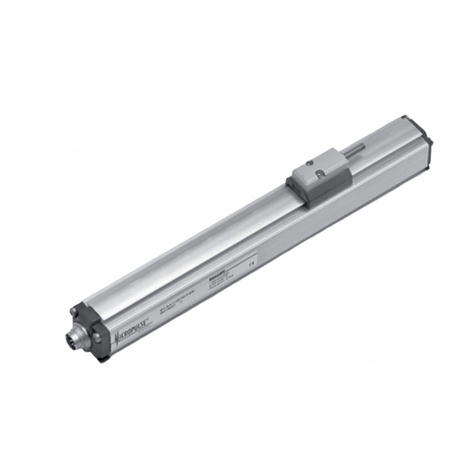
Balluff
Balluff Micropulse BTL5-A series user guide

FuehlerSysteme
FuehlerSysteme RAF/A operating manual

Veris Industries
Veris Industries PH Series installation instructions
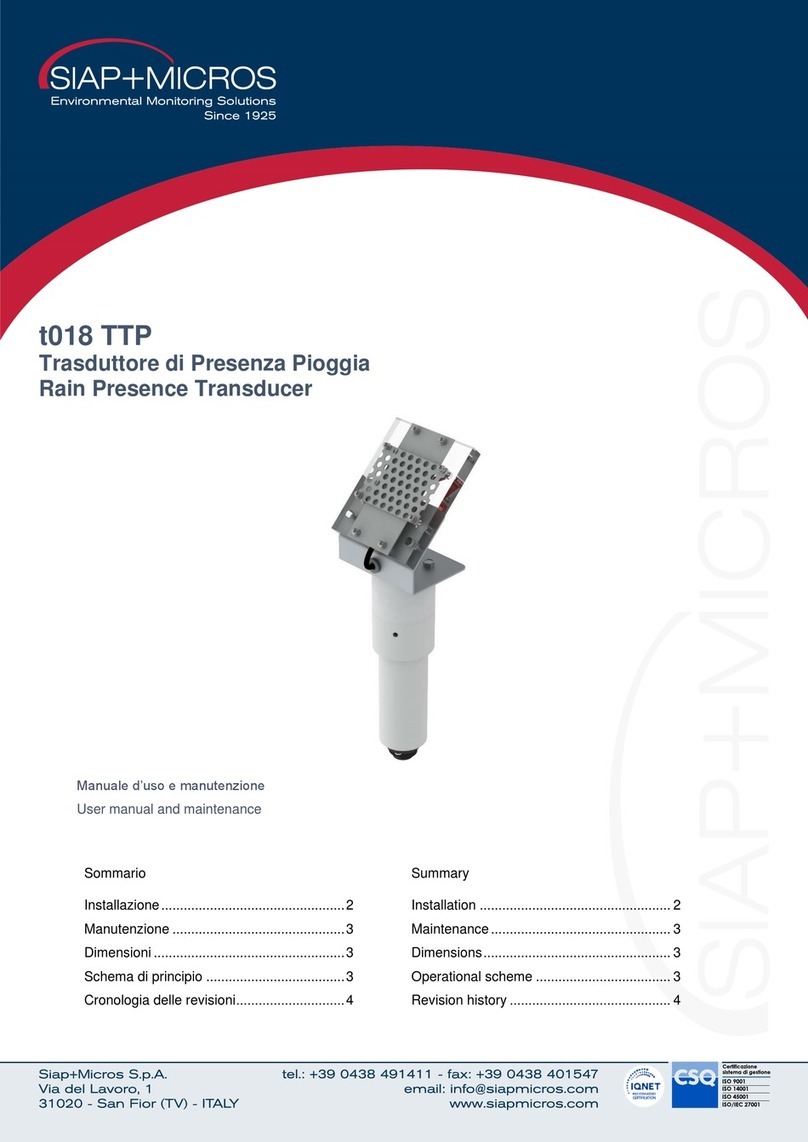
SIAP+MICROS
SIAP+MICROS t018 TTP User manual and maintenance
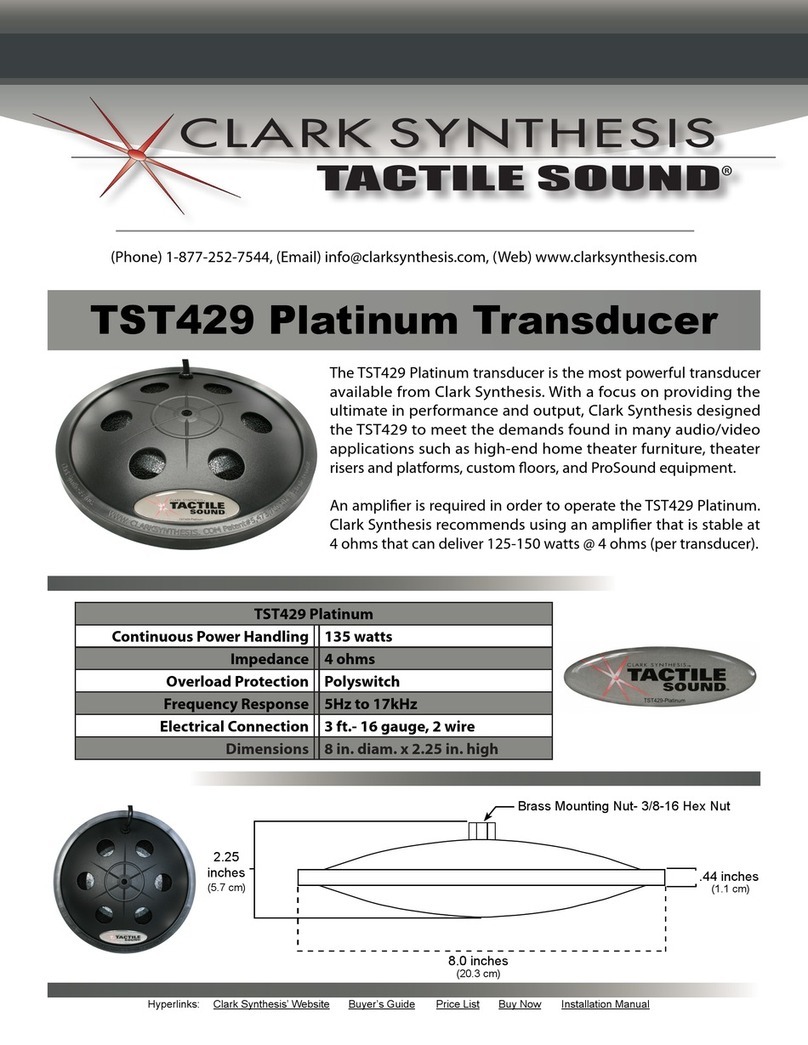
Clark Synthesis
Clark Synthesis TST429 specification

